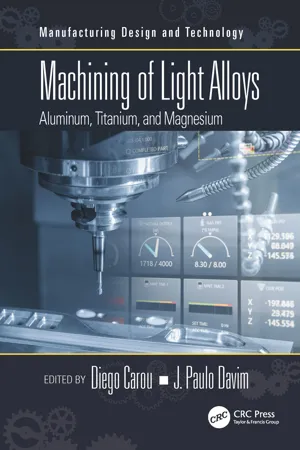
- 240 pages
- English
- ePUB (mobile friendly)
- Available on iOS & Android
About This Book
Aluminium, magnesium and titanium are alloys of special interest for engineering applications in a wide range of sectors such as aeronautics, automotive and medical. Their low density, along with sufficient mechanical properties, makes them especially adequate for sectors such as transportation allowing diminishing weight less fuel consumption and emissions to the atmosphere.
Nowadays, machining is still one the most important manufacturing processes, not only for metal parts, but also for specially designed hybrid parts for more demanding new applications. A wide range of valuable research has been done on the machining of conventional engineering materials. However, when dealing with light alloys and hybrid materials containing them, they need to face new challenges. Particularly, it is important to analyse the suitability of the machining of these alloys in the current context of Industry 4.0, focusing on the development of cost-effective and sustainable processes.
This book is a comprehensive source on the machining of light alloys, presenting a collection of both experimental and review studies. The work is arranged in eight chapters, presented by a group of international scholars, which analyse the main problems related to the machining of these alloys from different perspectives.
Key Features
-
- A comprehensive state-of-the-art reference source on machining of light alloys
- Provides research on conventional and non-conventional machining process
- Offers current research topics on sustainable machining
- Presents research on the machining of hybrid materials using light alloys
- Includes applications for Industry 4.0 environments
Machining of Light Alloys: Aluminum, Titanium, and Magnesium The aim of the book is to serve as a tool for helping researchers and practitioners to face machining challenges and facilitating the development of new industrial applications for light alloys.
Frequently asked questions
Information
Table of contents
- Cover
- Half Title Page
- Series Page
- Title Page
- Copyright Page
- Contents
- Preface
- Editors
- Author
- Chapter 1 Light alloys and their machinabilityA review
- Chapter 2 Investigation on the built-up edge process when dry machining aeronautical aluminum alloys
- Chapter 3 Advances in the machining of holes and internal threads in light alloys
- Chapter 4 Design, manufacturing, and machining trials of magnesium-based hybrid parts
- Chapter 5 Laser surface processing of magnesium alloys
- Chapter 6 Sensor monitoring of titanium alloy machining
- Chapter 7 Cryogenic machining of titanium alloys
- Chapter 8 Advanced technologies in drilling of light alloys and CFRP hybrid stacks for airframe structure manufacturing in the aerospace industry
- Index